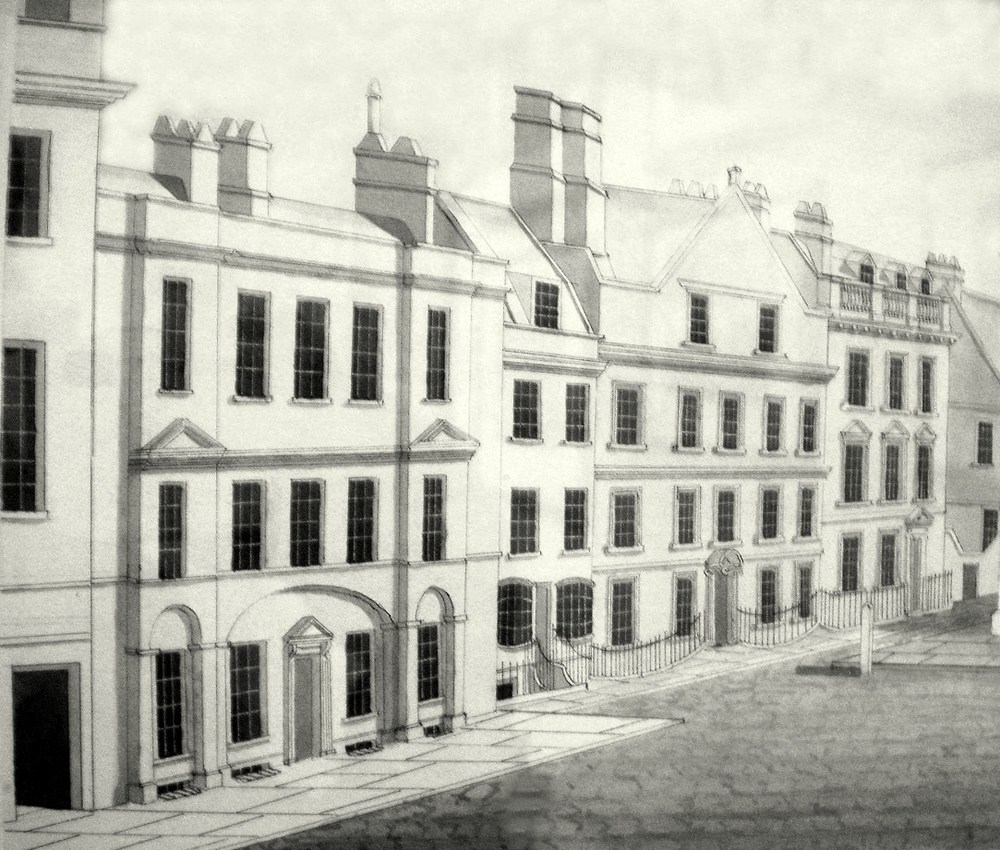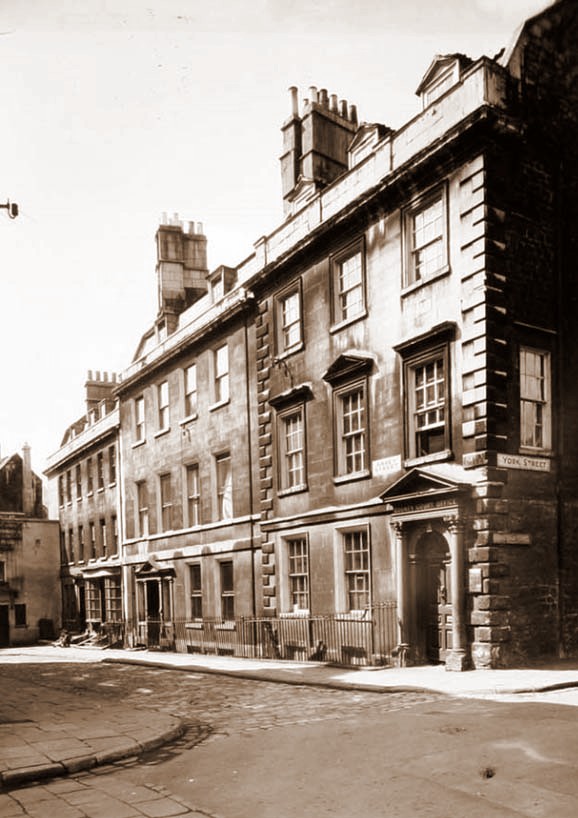Elton
House

A
pen and watercolour wash by William Blackamore in 1785 showing Elton House, next to The Crystal Palace on the left.


.jpg)
I was lucky enough to be invited into Miss Savery's charming house which lies right next to the Crvstal Palace and which used to be an antique shop, it is the one with the crinoline grille outside. It has always fascinated me.
We shall all be lucky enough to see it one day as Miss Savery has given it to 'Landmark' who, I understand, will restore it and display it as an example of a superior lodging house of its day - one with a powder closet on each floor - suitably furnished. The shop was bought by her after the war in 1946 and believe it or not, in that day had, as she put it, 'twelve homes' . These twelve homes were supplied with water by two taps on different floors and a tap in the basement which the previous owner of the shop, a cobbler by trade, kept for his own use. There was a further tap in the garden! She has all his tools in a heap unaci the back window - not having got round to clearing them u" The shop front has a curved window and another window erected inside, I suppose as a form of double glazing. When this inner window was taken down there were apparently, quite a few cobwebs there! As Miss Savery had bought the shop the Landlady insisted it was her duty to collect the rent from all the other occupants and this she had to do and was rewarded with the princely sum of one shilling as commission plus the joy of listening to the same tales of woe every week. This way she learnt something quite amusing. During the war the cellar was used as an air raid shelter and they all trooped there for safety and one old lady was noted for never going into the cellar until she had put her straw hat on. As each tenant left she made every effort to pay their rent until at last she owned 99 per cent of the house. Her Landlady died in 1962. When she finally owned the house she set about furnishing it and there is a lovely stone fireplace which replaced an ugly Victorian one in the back room. It came from a house on the corner of Abbey Green facing Marks and Spencers and she is only thankful she at least saved a bit of it.
As' one enters there is a long hall and a door to the right leads to the dining room which is panelled all over with Queen Anne panelling (c.1710). She thinks the house dates back to about 1690. This dining room is the 'back room' referred to earlier and looks out upon a little garden through Queen Anne windows. Beyond this garden you can see the big boiler chimney the other side of which is Swallow Street. Turning your back on the garden in the dining room facing Abbey Green, you see another large room and this was the shop, both The Cobbler's and then Miss Savery's, with the Bay window looking out onto Abbey Green. The back part of the house is older and Miss Savery thinks the wall dividing the dining room from the front room was once an outer wall before another house was built - back to back as it were. This front room has lovely wide floor boards and she believes another storey was later added because the floor boards on the next floor are of a later date. One must also remember that originally the street level was one floor further down, as in Sally Lunns. There are three floors more above; the house is unexpectedly lofty, looking very like those shown in Thomas Johnson's illustration of bathers in the King's Bath in 1675. There are also two cellars, one being very small indeed and was either a fresh water tank or a little room. There is a Roman well under her bedroom which is in that part of the house which abuts on to the Crystal Palace. Apparently the Roman pavement which has been found beneath the Pub actually continues on under her house. She told me the Crystal Palace took that name in 1851 when the Crystal Palace was built and until then had been the 'Three Tuns'.
I then went to see the garden which lies beyond the dining room and at the end of which is the boiler, chimney. When she first came, there was just a yard there and she brought soil in and made the garden. As you face the boiler chimney to your right is a cottage within the garden with no access at all from either Swallow or York Streets and Miss Savery is going to live in this cottage - direct entry by door from the dining room - whilst the main house is brought up to scratch. The cottage cost all of £15 when bought in 1850. One actually has to go one flight up a beautiful wooden staircase from the dining room to gain entry to the garden!!
It was a most enjoyable visit which was rounded off with a very interesting piece of information. Tupra, the jewellers in Abbey Green was once owned by sisters called Curtis who sold everything and anything from liquorice to paraffin. The interesting thing is that Bath chairs were also housed there at one time. They were lined up twelve in a row and hired out at sixpence a week. The big right hand window was once a door through which they could be trundled.
N.B. Miss Savery gets very upset about Guides standing on the central piece of grass in Abbey Green because it took ages to find the right type of grass to grow there in the first place and she finds the 'Fish & Chippers' bad enough. So perhaps we wouldn't mind sticking to the pavements or cobblestones in future. Thanks.